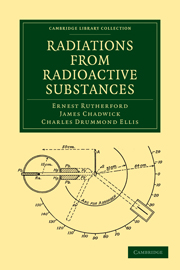Book contents
- Frontmatter
- Contents
- LIST OF PLATES
- Preface
- Chap. I Radioactive Transformations
- Chap. II The α Rays
- Chap. III Absorption of the α Rays
- Chap. IV Some Properties of the α Particle
- Chap. V Theories of Absorption of α Rays
- Chap. VI Secondary Effects produced by α Rays
- Chap. VII General Properties of the Radiations
- Chap. VIII The Scattering of α and β Particles
- Chap. IX The Collisions of α Particles with Light Atoms
- Chap. X The Artificial Disintegration of the Light Elements
- Chap. XI The Radioactive Nuclei
- Chap. XII β Ray and γ Ray Spectra
- Chap. XIII The Disintegration Electrons
- Chap. XIV The Passage of β Particles through Matter
- Chap. XV The Scattering and Absorption of γ Rays
- Chap. XVI Intensity Problems connected with the Emission of γ Rays
- Chap. XVII Atomic Nuclei
- Chap. XVIII Miscellaneous
- Appendix
- Subject Index
- Index of Names
- Plate section
Chap. V - Theories of Absorption of α Rays
Published online by Cambridge University Press: 07 September 2010
- Frontmatter
- Contents
- LIST OF PLATES
- Preface
- Chap. I Radioactive Transformations
- Chap. II The α Rays
- Chap. III Absorption of the α Rays
- Chap. IV Some Properties of the α Particle
- Chap. V Theories of Absorption of α Rays
- Chap. VI Secondary Effects produced by α Rays
- Chap. VII General Properties of the Radiations
- Chap. VIII The Scattering of α and β Particles
- Chap. IX The Collisions of α Particles with Light Atoms
- Chap. X The Artificial Disintegration of the Light Elements
- Chap. XI The Radioactive Nuclei
- Chap. XII β Ray and γ Ray Spectra
- Chap. XIII The Disintegration Electrons
- Chap. XIV The Passage of β Particles through Matter
- Chap. XV The Scattering and Absorption of γ Rays
- Chap. XVI Intensity Problems connected with the Emission of γ Rays
- Chap. XVII Atomic Nuclei
- Chap. XVIII Miscellaneous
- Appendix
- Subject Index
- Index of Names
- Plate section
Summary
§ 26 a. Theory of absorption of α particles. We have already discussed the experimental results which have been obtained on the retardation of the α particle in passing through matter, and the variation in atomic stopping power for the different elements. It is of great interest and importance to consider in some detail how far we are able to give a theoretical explanation of the observed facts.
It is clear that the α particles have such great energy of motion that they pass freely through the electronic structure of the atoms in their path, and it is only rarely that they pass close enough to the nucleus to experience a sensible deflection. In the calculations we shall disregard the scattering of the α particles and assume that the α particle travels in nearly a straight line through the matter in its path.
In consequence of its charge, it is evident that the α particle, in passing close to an atom or in penetrating it, must disturb the motions of the electrons in the atom. The amount of energy which is communicated to the electrons by the α particle can be calculated on certain assumptions, but it is difficult to be certain of their validity. The difficulties involved may be illustrated by the distinction made to-day between an “elastic” and “non-elastic” collision of an electron with an atom. Suppose, for example, that an electron of definite energy collides with a helium atom. For an energy less than 20 volts, the electron is supposed to make an elastic collision with the atom, i.e. it is deflected with a very slight reduction of its energy.
- Type
- Chapter
- Information
- Radiations from Radioactive Substances , pp. 134 - 146Publisher: Cambridge University PressPrint publication year: 2010First published in: 1930

